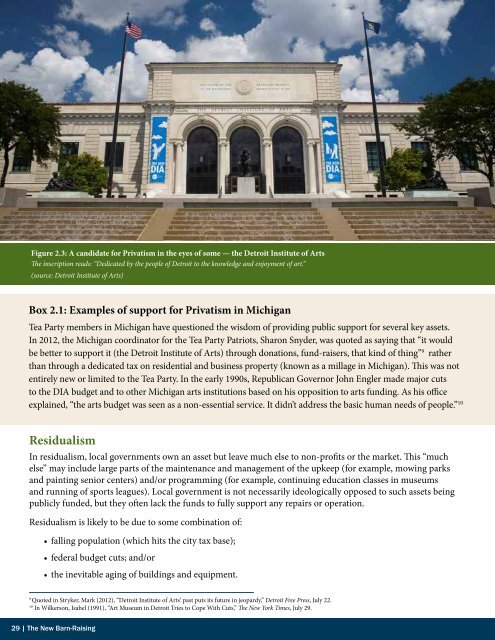bQNs7mR
bQNs7mR
bQNs7mR
You also want an ePaper? Increase the reach of your titles
YUMPU automatically turns print PDFs into web optimized ePapers that Google loves.
Figure 2.3: A candidate for Privatism in the eyes of some — the Detroit Institute of Arts<br />
The inscription reads: “Dedicated by the people of Detroit to the knowledge and enjoyment of art.”<br />
(source: Detroit Institute of Arts)<br />
Box 2.1: Examples of support for Privatism in Michigan<br />
Tea Party members in Michigan have questioned the wisdom of providing public support for several key assets.<br />
In 2012, the Michigan coordinator for the Tea Party Patriots, Sharon Snyder, was quoted as saying that “it would<br />
be better to support it (the Detroit Institute of Arts) through donations, fund-raisers, that kind of thing” 9 rather<br />
than through a dedicated tax on residential and business property (known as a millage in Michigan). This was not<br />
entirely new or limited to the Tea Party. In the early 1990s, Republican Governor John Engler made major cuts<br />
to the DIA budget and to other Michigan arts institutions based on his opposition to arts funding. As his office<br />
explained, “the arts budget was seen as a non-essential service. It didn’t address the basic human needs of people.” 10<br />
Residualism<br />
In residualism, local governments own an asset but leave much else to non-profits or the market. This “much<br />
else” may include large parts of the maintenance and management of the upkeep (for example, mowing parks<br />
and painting senior centers) and/or programming (for example, continuing education classes in museums<br />
and running of sports leagues). Local government is not necessarily ideologically opposed to such assets being<br />
publicly funded, but they often lack the funds to fully support any repairs or operation.<br />
Residualism is likely to be due to some combination of:<br />
• falling population (which hits the city tax base);<br />
• federal budget cuts; and/or<br />
• the inevitable aging of buildings and equipment.<br />
9<br />
Quoted in Stryker, Mark (2012), “Detroit Institute of Arts’ past puts its future in jeopardy,” Detroit Free Press, July 22.<br />
10<br />
In Wilkerson, Isabel (1991), “Art Museum in Detroit Tries to Cope With Cuts,” The New York Times, July 29.<br />
29 | The New Barn-Raising


